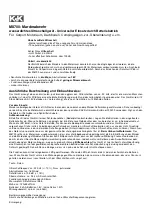
WARNING
It is important to follow the instruction below carefully so as to avoid a shock load to the
gears on the blades and cone gear, that could be damaging to the teeth.
•
When going from forward to reverse and the opposite, it is necessary to idle down and
shift at low RPM’s between gear, that could be damaging to the teeth.
PROPELLER REMOVAL
In order to remove the propeller you must first
remove the
zinc and remove the nut. Next fit a long armed gear puller
over the front of the propeller as shown in Fig.7 on page 8.
Tightening the center bolt of the gear puller will release the
Max-Prop from the propeller shaft.
If the bolt from the gear puller is not long enough to contact
the end of the propeller shaft inside the Max-Prop nut can
be loosened and left in place. In this scenario the bolt from
the puller will push against the back of the nut to release the
propeller from the shaft.
Fig.7
PROPER FITTING OF A NEW LOCKING NUT OF THE PROPELLER
If the shaft nut needs to be replaced at any time during the life of the propeller, it will need to be
fit to this propeller with the correct tolerances (may require some light machining). Of course,
when receiving a new propeller, the nut has already been machined to fit with the proper
tolerances.
1.
When it’s locked on the motor shaft, the nut must contact the 3 surfaces S1, S2, S3.
Therefore, if a new nut has to be machined you must be sure that length L1 and L2 coincide
precisely with the corresponding lengths of prop hub, and that length L3 is greater than
the length of the threaded edge of motor shaft. To check that the work is done properly,
you just have to spread a very thin coat of Prussian blue on the 3 surfaces S1, S2, S3. Insert
the nut in its seat in the hub and let the nut rotate softly in relation to the hub, with a light
pressure. When this is done, the 3 surfaces of the hub must be painted in blue.
2.
When fitting the prop on the motor shaft, it’s necessary to check that the threaded part
of the motor shaft doesn’t touch the threaded end of the nut. Also, when the nut is tight,
the blades rotation on their axis does not get hard. In case the blades rotation movement
becomes hard, you have to remove from surface S1 a very small amount of material. This
operation can be done simply by using a flat smooth file.
L2
S1
S2
S3
L1
L3
Shaft Nut
Fig.8
8
Summary of Contents for Max-Prop EASY 2 Blade
Page 10: ...Notes 9 ...
Page 11: ...Notes 10 ...






























